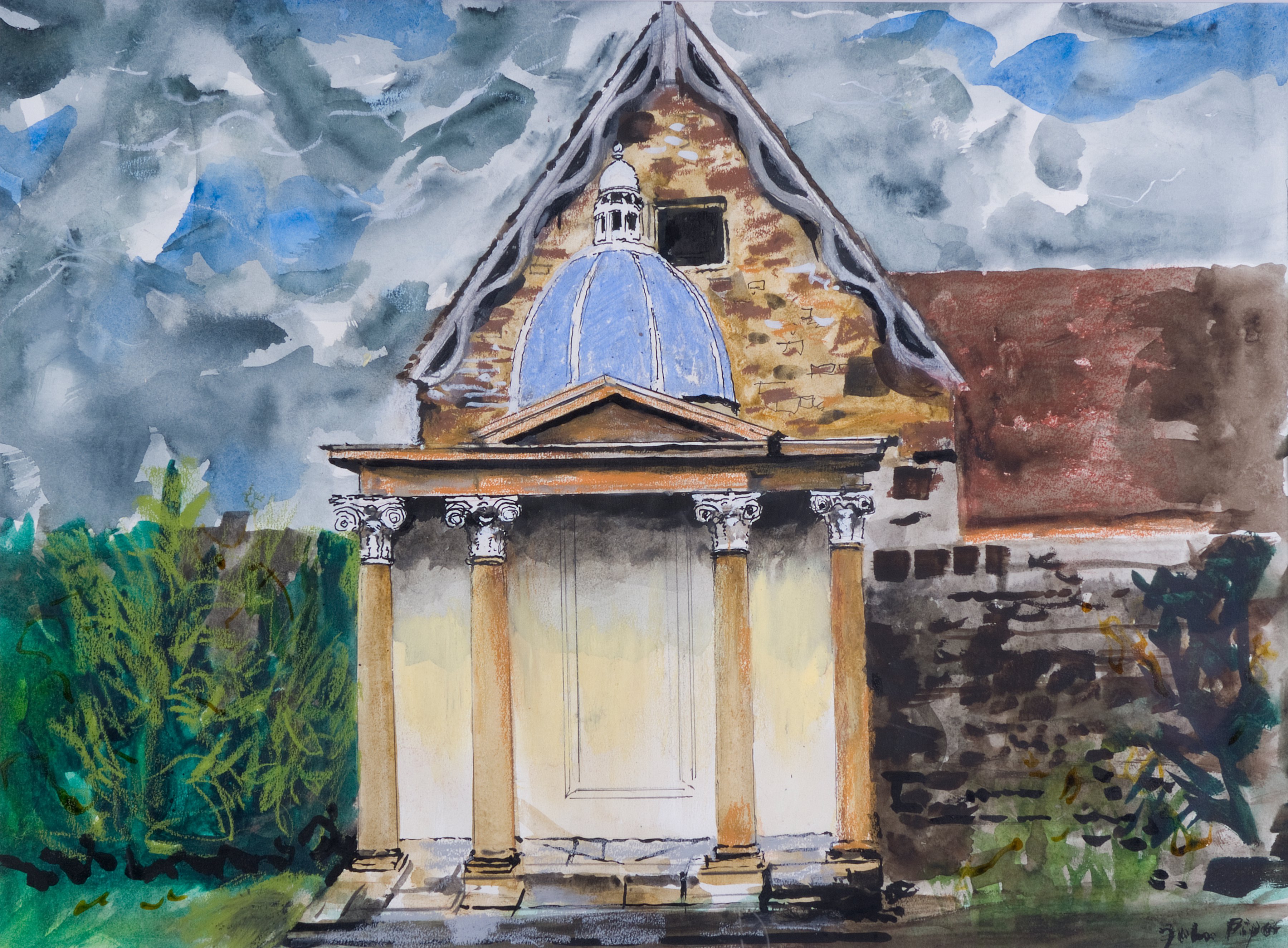25. St Giles' House, Summerhouse, by John Piper
 John Piper (1903-1992), St Giles’ House, Summerhouse, 1987, watercolour and pastel
John Piper (1903-1992), St Giles’ House, Summerhouse, 1987, watercolour and pastel
John Piper’s watercolour of the
summerhouse at St Giles’ House is typical of his composite works
that bring together architectural detail, weather, a clear sense of place, and
combine watercolour with interjections of mixed media – as can be seen in the
pastel marks in the hedge on the left. That this is a sketch is suggested by
the relatively underworked nature of the piece as a whole – in comparison to
similar pieces by Piper, albeit several decades earlier (see for example All Saints Chapel, Bath, 1941),
there is less further interrogation of the subject in pen and the sky in
particular is left loosely painted. What is interesting here is that the finer
detail of the ionic capitals and the dome of the summerhouse are all but
dwarfed by the treatment in broad brushstrokes of watercolour such as the hedge
and stone wall, and the unnuanced roof that extends to the right. Similarly,
although the colour of the summerhouse coincides with the Cotswold sandstone of
the building behind, the rough texture of the latter looms over the summerhouse
in contrast to the refined lines of the dome of the summerhouse – it is a
combination of traditions, something that would have appealed strongly to
Piper. The dome of the summerhouse is thought to be based on James Gibb’s 1734
model for the stone dome he designed for the Radcliffe Camera, and Piper’s
depiction here emphasizes both the materialities and histories that emanate
from this small space within Oxford. The space is itself an illustration, and
Piper takes this up, translating it into detail and affective space. However, the
relative diminution of the subject in this painting has a curious effect on the
composition – on the one hand, the summerhouse is cocooned within the garden
that houses it, and on the other the composition fragments around it into
quartered patches of hedge, sky, roof and wall; divisions exacerbated by the
strong separate colours of each part.
Piper, along with artists such as Paul
Nash and Graham Sutherland belonged to a generation of artists whose work
between the wars and post-war have shaped the British imagination – and
especially the envisioning of the British landscape. Deliberate projects shaped
this influence, including, for Piper, his contribution of illustrations to the
Shell Guides to the British Counties, published in 1934 and edited by the poet
John Betjemen. Piper was then involved with Kenneth Clark’s ‘Recording Britain’
scheme, founded in 1939. This scheme was designed to capture images of
Britain’s architectural heritage which was now under threat by war. Inherent in
this was a pending sense of loss that was also associated by a certain
Neo-Romantic resistance to the industrial. These works – as had the Shell
Guides – returned to eighteenth-century ideas of the picturesque, which in
Britain had concentrated on the ‘pictured experience’ of the local landscape
and an almost fetishized approach to architectural and organic topographical
details. (Oak trees get a particular
attention in the work of writer William Gilpin (1724-1804) who published
writings and sketches from tours of Britain and, perhaps most influentially, Three essays: On Picturesque beauty; On
Picturesque travel; and on sketching landscape (1792)).
However, it is a mistake to see Piper
only within this often-parochial mode. Not only did he work in theatre design
as well as ceramics, print-making, and a host of collaborative projects, but he
was also an advocate of International Modernism in the 1930s alongside
constructionist painters such as Ben Nicholson, and exhibited with the Seven
and Five Society. In works such as Abstract I (1935)
Piper
embraces geometric form and inherits from Cubism an interest in the arrangement
of these forms within the flattened space of the canvas. Although he turned
away from abstraction, writing to Nicholson that he needed to find a more
adequate form of expression for landscape, Piper remained influenced and
enthusiastic about developments in contemporary art such as collage and
construction. In particular, his works depicting archaeological sites (see The Forum (1961)) use a
wholly modern mark-making and shifting temporality in the accumulation of
images they bring together to create works that explicitly engage with the
relation of the past and present.
By the 1980s, when the watercolour of
the summer house at St Giles’ House was made, something of a revival of
interest in Piper’s work was happening. In the climate of object-oriented
abstractions and conceptual art in the preceding decades, his work had seemed
archaic. Piper’s presence in various exhibitions spoke to how tricky he was to
categorize as a painter – and how institutions tended to place him exclusively
in particular camps. At the Royal Academy’s 1987 show British Art in the 20th Century, only his highly
abstract work was shown, while in 1988 he was a central figure in the
Barbican’s exhibition Paradise Lost: The
Neo-Romantic Imagination in Britain, 1935-1955. In particular at this time,
a young Marxist critic, Peter Fuller, championed Piper, and – perhaps
counter-intuitively – his claims for the importance of tradition and
imagination. Fuller felt that there was a crisis in art, and in society, and
that an imaginative connection with the past in response to the ‘visible
present’ was one way out of the crisis.
However, from around 1987 onwards,
Piper was experiencing the beginnings of a mental decline that would see him
give up painting altogether in 1989. Ironically, as Frances Spalding has noted,
as the structures of some his subjects began to give way a startling freedom
emerged in his painterly practice as his skills in the application of paint in
itself took over.[1]
Something of this can be seen in the St Giles’ sketch with its energetic
brush-work, but even as past and present press upon each other as so often in
Piper’s work, despite the bright sky, there is a forlornness in the enclosed
empty space of the summerhouse.
[1] See Frances Spalding, John Piper: Myfanwy Piper: lives in art (Oxford University Press: Oxford, 2009)
 Dr Jennifer Johnson, Junior Research Fellow in History of Art
Dr Jennifer Johnson, Junior Research Fellow in History of Art